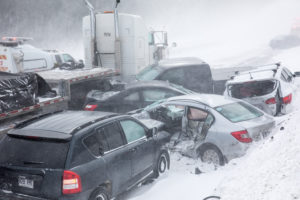 With the winter season comes black ice, heavy snowfall, and hazardous road conditions that can increase the risk of getting into a car accident. During the first 2020 snowfall on November 4, Halifax police say they responded to more than 80 calls. Multiple crashes were reported, including a nine-car pile-up in Clayton Park and collisions on both the McKay and the Macdonald bridge, which had to be shut down.
With the winter season comes black ice, heavy snowfall, and hazardous road conditions that can increase the risk of getting into a car accident. During the first 2020 snowfall on November 4, Halifax police say they responded to more than 80 calls. Multiple crashes were reported, including a nine-car pile-up in Clayton Park and collisions on both the McKay and the Macdonald bridge, which had to be shut down.
According to Traffic Accident Information System (TAIS) reports, snowdrift was a factor in over 500 accidents, and packed snow or ice was present in over 7,500 traffic accidents (more than 26% of total accidents). Between the months of December and January, automobile accidents typically increase by an average of 3.1-4.7%, with Canadian insurance providers reporting a 49% rise in claims.
No matter how much driving experience you have or how safe the roads appear, winter weather often creates icy road conditions that you may not be aware of until they are right under your wheels. While the driver is held responsible for taking precautions when driving during the winter, insurance companies may make some allowances for car accidents caused by weather-related events.
Fault in Weather-Related Auto Accidents
With any car accident claim, the insurance company will review the circumstances that caused the accident to assess liability. While the weather will be a factor in determining fault, most insurance companies hold the driver responsible for operating a vehicle safely and appropriately, no matter the road conditions.
Insurance providers determine fault for a winter accident the same way they do for all motor vehicle accidents. Some legal fees may be waived due to road conditions, but the insurer is required to determine fault based on the rules set out by the Automobile Insurance Fault Regulations. These rules are used to assess the coverage for property damages and to ensure the premiums of the driver who was more than 25 percent at-fault are appropriately adjusted. Fault can be determined at 100% for one driver, 50% for each driver, or any other range of percentages.
In some cases, a 50-50 fault determination may be shared among two cars that collide due to weather conditions. If your insurer determines you to be at-fault in a winter accident and you disagree, you have the right to appeal the decision. Unless you can show that another party was solely responsible for the collision, it may be difficult to change the fault determination. Unfortunately, weather-related accidents are typically reported on your insurance record, which can increase the cost of your premiums.
No-Fault Benefits
Under Section B of Nova Scotia’s standard form auto insurance policy, insured drivers are entitled to coverage for medical expenses up to $50,000 regardless of who is at fault for the accident. Commonly referred to as No-Fault Benefits or Accident Benefits, Section B of your car insurance policy provides coverage for medical expenses, loss of income, housekeeping expenses, funeral expenses, and death benefits. This coverage is available to the policyholder, driver and passengers of the insured vehicle, pedestrians who are hit by the insured vehicle, and dependant and family members who were occupants of other vehicles.
Does Insurance Cover Car Accidents Caused by Black Ice?
Black ice is a thin layer of frozen moisture that is visually transparent, making it hard for drivers to spot. If your car drives over a patch of black ice that results in a collision with another vehicle, you may feel that the poor road conditions are responsible for the accident. However, the insurance company may consider you to be at-fault for not taking the necessary precautions when driving in hazardous winter conditions.
The Nova Scotia Insurance Act clearly spells out that you can’t blame an auto accident on weather or road conditions. According to the Fault Determination Regulations, ” The degree to which an insured is at fault in an incident must be determined without reference to the circumstances in which the incident occurs, including weather conditions, road conditions, visibility or the actions of pedestrians.” Every time someone chooses to drive in winter conditions, they can be held liable if they cause an accident.
Only in extremely rare cases have accidents been deemed unavoidable due to weather conditions. In some instances, there are situations in which someone or some entity could have done something to prevent the collision. For example, suppose a roadway was not properly maintained or designed in a way that does not allow water to drain efficiently, resulting in icy road conditions. In that case, a municipality or organization may be held liable for the accident. Additionally, if a road was not salted or cleared after a snowstorm or during temperatures below 0 degrees celsius when black ice can form, the maintenance company could be found at fault.
What to do if You’re in an Accident During a Snowstorm
1. The first step to take after a car accident in a snowstorm or weather-related event is to check yourself and your passengers for injuries. It is important to note that the body releases high levels of adrenaline following a motor vehicle accident or traumatic event. This is a natural hormone produced by the body during the flight or fight response that blocks the recognition and sensation of pain. As a result, it is very common for people to not become aware of a car accident-related injury for days or weeks after the impact.
2. The next step is to call 911 and seek medical attention. In Nova Scotia, a police report is required by law if there is more than $2,000 worth of property damage to either vehicle. Be sure to get a copy of the official police and medical reports to support your insurance claim or lawsuit if you pursue legal action.
3. Collect contact information from all parties involved in the collision. Be mindful of limiting your conversation to the necessary information you need when talking to the other driver(s). You will need to get the full name and contact information of the other driver(s), insurance policy information, license plate number(s), and driver’s license information. You should also record the make, model, and colour of all vehicles involved in the crash.
4. Document the scene using photos, videos, and notes. Even though the responding officer will include details of the accident in the police report, it is in your best interests to have your own record of events. Details to collect from the scene can include the date, time, and location of the accident, and photos of vehicle damage and your injuries. You may also want to take notes on how the crash happened. Writing down the details after an accident is often more accurate than relying on your memory.
5. Submit a claim with your insurance provider. Claims take time to process, so it is in your best interest to file a claim as soon as possible following a car accident. If you believe another person is responsible for causing the collision, you can file what is known as a third-party claim with the other driver’s insurance provider. To ensure you are treated fairly when filing a third-party claim, you may want to have an insurance agent from your provider or a personal injury lawyer handle the interactions with the other insurer on your behalf.
How to Avoid Winter Car Accidents
Most of us do our best to drive with caution, especially during winter months, when the road conditions are less than favourable. That said, the reality is that every time you get behind the wheel, there is a risk of getting into an accident. There are precautions drivers should take, especially during snowfall and freezing temperatures, to help keep everyone on the road safe.
Prepare your car for winter
This may seem like a no-brainer, but you would be surprised how many people wait until the last minute to put snow tires on their car. Check tire treads to make sure you will have enough traction on the road, switch to windshield wiper fluid that contains anti-freeze, and always defrost your windows thoroughly before driving.
Slow down
A lot of drivers tend to speed up during snowfall to get home faster before the storm gets worse. It takes 3 to 12 times the average distance to stop on ice and snow-covered roads than on dry roads. Take your time and leave extra room between the car in front of you.
Stay home
If possible, avoid driving in winter conditions altogether. If you need to travel, you may want to arrange alternative transportation. If you are using a taxi or rideshare service, make sure the driver is taking precautions and choosing the safest route to your destination.
Unfortunately, you cannot control the weather or other drivers on the road. If you or someone you know has been injured in a car accident caused by winter road conditions, contact a personal injury lawyer at Valent Legal for a free, no-obligation case evaluation. Our team of experienced car accident lawyers will review the circumstances of your accident and provide you with legal options to recover the compensation you deserve.








